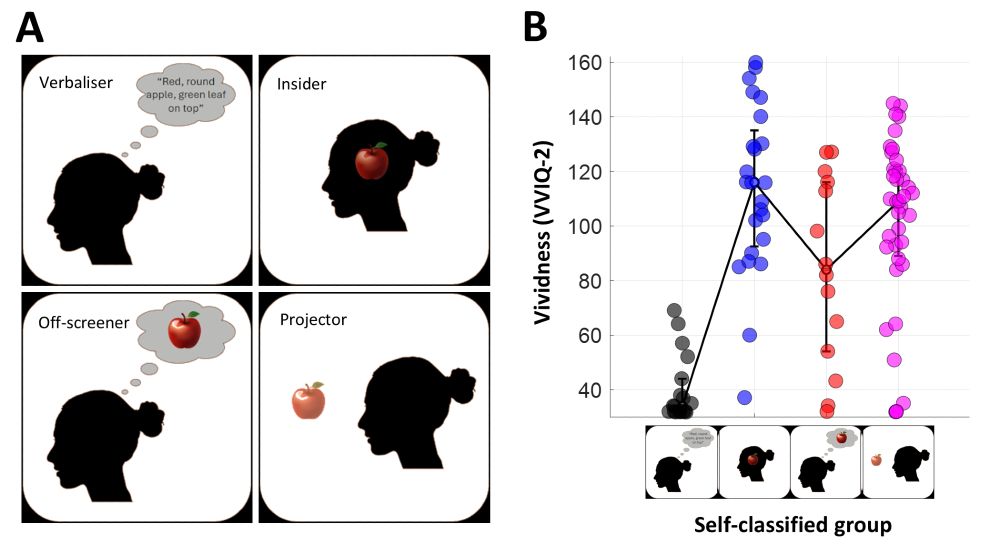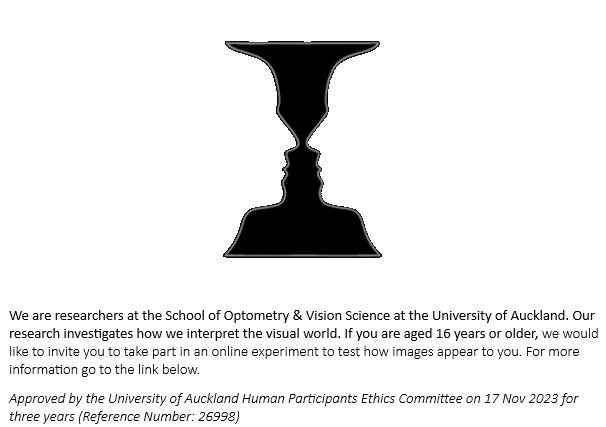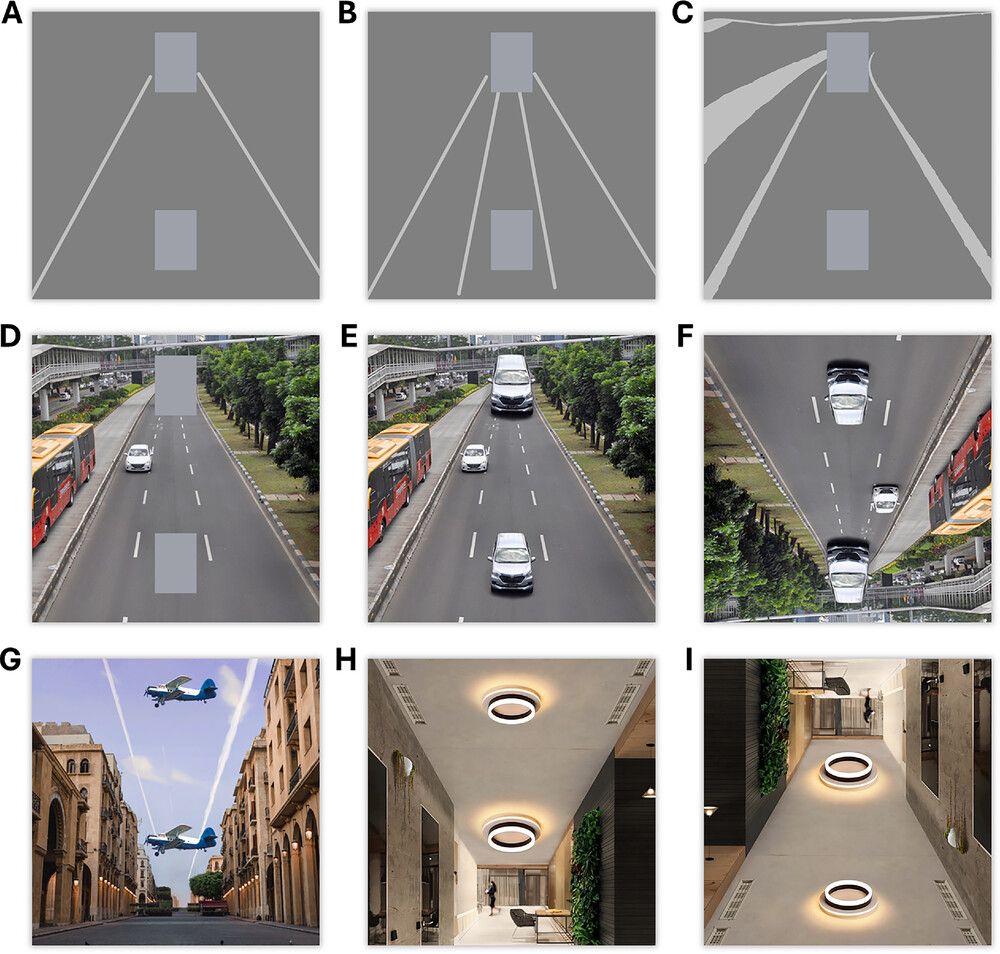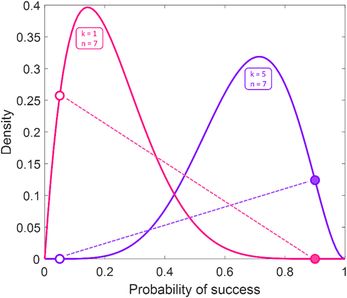Sam Schwarzkopf
@sampendu.bsky.social
Kiwified neuroscientist & perception researcher at the School of Optometry & Vision Science at Waipapa Taumata Rau | University of Auckland, Aotearoa New Zealand. Lab website: sampendu.net
#UltimaDragon
#UltimaDragon
SAVE THE DATE! Australasian Society for Experimental Psychology (EPC) & Asia-Pacific Conference on Vision (APCV) Joint Meeting from 1-4 July at the University of Auckland, NZ.
#PsychSciSky #VisionScience #neuroskyence
More information to follow!
visualneuroscience.auckland.ac.nz/epc-apcv-2026/
#PsychSciSky #VisionScience #neuroskyence
More information to follow!
visualneuroscience.auckland.ac.nz/epc-apcv-2026/

October 20, 2025 at 8:54 PM
SAVE THE DATE! Australasian Society for Experimental Psychology (EPC) & Asia-Pacific Conference on Vision (APCV) Joint Meeting from 1-4 July at the University of Auckland, NZ.
#PsychSciSky #VisionScience #neuroskyence
More information to follow!
visualneuroscience.auckland.ac.nz/epc-apcv-2026/
#PsychSciSky #VisionScience #neuroskyence
More information to follow!
visualneuroscience.auckland.ac.nz/epc-apcv-2026/
Just one more point: we also found that our beach cartoon question correlated strongly with VVIQ2 scores. In fact, this correlation is stronger than most VVIQ items correlate with each other. Combined with how tedious & repetitive the VVIQ is, I believe it's high time we put that instrument to rest

October 2, 2025 at 7:26 PM
Just one more point: we also found that our beach cartoon question correlated strongly with VVIQ2 scores. In fact, this correlation is stronger than most VVIQ items correlate with each other. Combined with how tedious & repetitive the VVIQ is, I believe it's high time we put that instrument to rest
We find that conventional vividness questionnaire scores correlate quite strongly with all these measures - especially the freestyle question in A. But the relationship breaks down somewhat for the "seeing" questions in C&D. About 1 in 5-6 people who report not seeing anything have high VVIQ scores

October 2, 2025 at 7:08 PM
We find that conventional vividness questionnaire scores correlate quite strongly with all these measures - especially the freestyle question in A. But the relationship breaks down somewhat for the "seeing" questions in C&D. About 1 in 5-6 people who report not seeing anything have high VVIQ scores
Obviously, none of this is proof of anything. We could all just be talking past each other. But for me the sheer volume of these divergent descriptions is telling. So we tried to dig deeper. In our survey we included cartoon questions inspired by internet memes, with very explicit instructions:

October 2, 2025 at 7:01 PM
Obviously, none of this is proof of anything. We could all just be talking past each other. But for me the sheer volume of these divergent descriptions is telling. So we tried to dig deeper. In our survey we included cartoon questions inspired by internet memes, with very explicit instructions:
First, we review some studies that suggest (to some of us anyway) that many #mentalimagery researchers assume their participants can literally* "see" imagined stimuli: they might talk about mental images appearing "gradually" or suggest that a mental image of black lines appears light grey...

October 2, 2025 at 6:43 PM
First, we review some studies that suggest (to some of us anyway) that many #mentalimagery researchers assume their participants can literally* "see" imagined stimuli: they might talk about mental images appearing "gradually" or suggest that a mental image of black lines appears light grey...
Long time in the making: our preprint of survey study on the diversity with how people seem to experience #mentalimagery. Suggests #aphantasia should be redefined as absence of depictive thought, not merely "not seeing". Some more take home msg:
#psychskysci #neuroscience
doi.org/10.1101/2025...
#psychskysci #neuroscience
doi.org/10.1101/2025...

October 2, 2025 at 6:10 PM
Long time in the making: our preprint of survey study on the diversity with how people seem to experience #mentalimagery. Suggests #aphantasia should be redefined as absence of depictive thought, not merely "not seeing". Some more take home msg:
#psychskysci #neuroscience
doi.org/10.1101/2025...
#psychskysci #neuroscience
doi.org/10.1101/2025...
Just looking at those data sets it seems quite obvious there is a bimodal distribution in the aphantasia groups in most studies. We see similar in our own study: Many people who say they have depictive imagery score low on VVIQ - all they way down to the minimum score of 32.

October 1, 2025 at 11:23 PM
Just looking at those data sets it seems quite obvious there is a bimodal distribution in the aphantasia groups in most studies. We see similar in our own study: Many people who say they have depictive imagery score low on VVIQ - all they way down to the minimum score of 32.
And either way, the issue with variable definitions is quite wide-spread in the literature. Here is a non-exhaustive summary 🙂

October 1, 2025 at 11:16 PM
And either way, the issue with variable definitions is quite wide-spread in the literature. Here is a non-exhaustive summary 🙂
On the topic of pRF data quality, our next manuscript will be on fitting the HRF in the analysis (those who were at VSS2025 may have seen my talk on this). This reduces several likely pRF artifacts. When we did this on Ecem's data we reproduce the SF adaptation effect (again most clear in V2).

September 30, 2025 at 12:14 AM
On the topic of pRF data quality, our next manuscript will be on fitting the HRF in the analysis (those who were at VSS2025 may have seen my talk on this). This reduces several likely pRF artifacts. When we did this on Ecem's data we reproduce the SF adaptation effect (again most clear in V2).
Ecem Altan's excellent study showing that adaptation to spatial frequency modulates pRF estimates now published:
doi.org/10.7554/eLif...
I mostly enjoyed the novel review process - except that @elife.bsky.social apparently did not publish our final reply to reviewers😒
#visionscience #neuroskyence
doi.org/10.7554/eLif...
I mostly enjoyed the novel review process - except that @elife.bsky.social apparently did not publish our final reply to reviewers😒
#visionscience #neuroskyence

September 29, 2025 at 11:00 PM
Ecem Altan's excellent study showing that adaptation to spatial frequency modulates pRF estimates now published:
doi.org/10.7554/eLif...
I mostly enjoyed the novel review process - except that @elife.bsky.social apparently did not publish our final reply to reviewers😒
#visionscience #neuroskyence
doi.org/10.7554/eLif...
I mostly enjoyed the novel review process - except that @elife.bsky.social apparently did not publish our final reply to reviewers😒
#visionscience #neuroskyence
Opinion piece now published as part of special issue in Neuropsychologia: #visionscience #neuroskyence #psychscisky #illusions doi.org/10.1016/j.ne...
Also, this happens to be my 100th publication. Join me for 🍺in OGH on Friday afternoon! 🙂
Also, this happens to be my 100th publication. Join me for 🍺in OGH on Friday afternoon! 🙂

July 9, 2025 at 1:34 AM
Opinion piece now published as part of special issue in Neuropsychologia: #visionscience #neuroskyence #psychscisky #illusions doi.org/10.1016/j.ne...
Also, this happens to be my 100th publication. Join me for 🍺in OGH on Friday afternoon! 🙂
Also, this happens to be my 100th publication. Join me for 🍺in OGH on Friday afternoon! 🙂
If you have 10-20 minutes (depends on how fast you are), would you please consider doing this online study on #mentalimagery? It contains a survey & an experiment where you look at pictures and you respond what you see:
#psychscisky #neuroskyence #visionscience
tstbl.co/820-917
#psychscisky #neuroskyence #visionscience
tstbl.co/820-917

July 7, 2025 at 1:51 AM
If you have 10-20 minutes (depends on how fast you are), would you please consider doing this online study on #mentalimagery? It contains a survey & an experiment where you look at pictures and you respond what you see:
#psychscisky #neuroskyence #visionscience
tstbl.co/820-917
#psychscisky #neuroskyence #visionscience
tstbl.co/820-917
There you go. Much more credible than this preprint... 😏
(Also: We are all doomed...)
(Also: We are all doomed...)

May 29, 2025 at 2:24 AM
There you go. Much more credible than this preprint... 😏
(Also: We are all doomed...)
(Also: We are all doomed...)
Here my attempt to reproduce results in Fig 4. The data aren't public but I managed to extract the data values from that figure reasonably well I think. As one might expect from this amount of scatter, the R^2 here is below 50% rather than the 91% reported. Curious to know what happened here... 🤨

May 27, 2025 at 3:44 AM
Here my attempt to reproduce results in Fig 4. The data aren't public but I managed to extract the data values from that figure reasonably well I think. As one might expect from this amount of scatter, the R^2 here is below 50% rather than the 91% reported. Curious to know what happened here... 🤨
Ahem... While on the topic of #aphantasia & #mentalimagery: This preprint reports correlations between questionnaires & some measure of hippocampal asymmetry that explain 90-100% of variance. Whenever I see data like this, I'd immediately suspect a bug in the code.
doi.org/10.31234/osf...
doi.org/10.31234/osf...

May 27, 2025 at 3:35 AM
Ahem... While on the topic of #aphantasia & #mentalimagery: This preprint reports correlations between questionnaires & some measure of hippocampal asymmetry that explain 90-100% of variance. Whenever I see data like this, I'd immediately suspect a bug in the code.
doi.org/10.31234/osf...
doi.org/10.31234/osf...
New #neuroskyence #visionscience by my excellent colleague Ecem Altan: We study higher-level processes in Ponzo-like illusions. In brief, inversion reduces the illusion & V1 activity reflects that difference, suggesting the V1 effect isn't just from feedforward processing:
doi.org/10.1098/rspb...
doi.org/10.1098/rspb...

May 14, 2025 at 1:18 AM
New #neuroskyence #visionscience by my excellent colleague Ecem Altan: We study higher-level processes in Ponzo-like illusions. In brief, inversion reduces the illusion & V1 activity reflects that difference, suggesting the V1 effect isn't just from feedforward processing:
doi.org/10.1098/rspb...
doi.org/10.1098/rspb...
All right let's true this again: I'll soon submit this to a special issue on the neural processes underlying sensory illusions:
In defence of empirical reductionism – Rejecting the hidden dualism of irreducible brain complexity
doi.org/10.31219/osf...
#neuroskyence #psychscisky #visionscience
In defence of empirical reductionism – Rejecting the hidden dualism of irreducible brain complexity
doi.org/10.31219/osf...
#neuroskyence #psychscisky #visionscience

March 7, 2025 at 12:14 PM
All right let's true this again: I'll soon submit this to a special issue on the neural processes underlying sensory illusions:
In defence of empirical reductionism – Rejecting the hidden dualism of irreducible brain complexity
doi.org/10.31219/osf...
#neuroskyence #psychscisky #visionscience
In defence of empirical reductionism – Rejecting the hidden dualism of irreducible brain complexity
doi.org/10.31219/osf...
#neuroskyence #psychscisky #visionscience
Actually it turns out that the OSF now hides preprints until they pass moderation. Which in the past took months or years... So I deleted the post and won't repost until the preprint is public. But here is the figure: 🙂

March 5, 2025 at 12:24 AM
Actually it turns out that the OSF now hides preprints until they pass moderation. Which in the past took months or years... So I deleted the post and won't repost until the preprint is public. But here is the figure: 🙂
Our study on size illusions & different tasks for measuring them is now officially published in Vision Research:
Shows different illusions likely involve separable processes & so do different tasks (adjustment vs 2AFC):
doi.org/10.1016/j.vi...
#visionscience #neuroskyence #psychscisky
Shows different illusions likely involve separable processes & so do different tasks (adjustment vs 2AFC):
doi.org/10.1016/j.vi...
#visionscience #neuroskyence #psychscisky

February 24, 2025 at 11:26 PM
Our study on size illusions & different tasks for measuring them is now officially published in Vision Research:
Shows different illusions likely involve separable processes & so do different tasks (adjustment vs 2AFC):
doi.org/10.1016/j.vi...
#visionscience #neuroskyence #psychscisky
Shows different illusions likely involve separable processes & so do different tasks (adjustment vs 2AFC):
doi.org/10.1016/j.vi...
#visionscience #neuroskyence #psychscisky
Here is a new, shorter version of our mental imagery survey. Please if you can spare a few minutes we would appreciate if you could take this & pass it along to others who might be interested. Thanks! tstbl.co/763-452
#neuroskyence #visionscience #psychscisky #aphantasia #mentalimagery
#neuroskyence #visionscience #psychscisky #aphantasia #mentalimagery

February 20, 2025 at 11:53 PM
Here is a new, shorter version of our mental imagery survey. Please if you can spare a few minutes we would appreciate if you could take this & pass it along to others who might be interested. Thanks! tstbl.co/763-452
#neuroskyence #visionscience #psychscisky #aphantasia #mentalimagery
#neuroskyence #visionscience #psychscisky #aphantasia #mentalimagery
If you look at our Figure 1G you can see just how much stronger but far less variable it is than the Ebb or Del illusion. And the Ponzo is way weaker (although that had been well known for some time)

February 19, 2025 at 2:37 AM
If you look at our Figure 1G you can see just how much stronger but far less variable it is than the Ebb or Del illusion. And the Ponzo is way weaker (although that had been well known for some time)
All right, this is the masterpiece after preregistering N=12 based on evidence threshold & then being asked to run 12 more observers. But fastest acceptance ever (a few hours). Soon to be out in Vision Research but final preprint available here: doi.org/10.1101/2024...
#VisionScience #Neuroscience
#VisionScience #Neuroscience

February 18, 2025 at 9:50 PM
All right, this is the masterpiece after preregistering N=12 based on evidence threshold & then being asked to run 12 more observers. But fastest acceptance ever (a few hours). Soon to be out in Vision Research but final preprint available here: doi.org/10.1101/2024...
#VisionScience #Neuroscience
#VisionScience #Neuroscience
I joined #UltimaDragons in 1998 (I think?) starting off with a different name but have been known as Ymochel Dragon ever since. My new approach to life these days is to drastically limit social media & Blue Sky is really exclusively for work. But I'm making an exception for my fellow wyrms... 🐉🐲

January 28, 2025 at 10:08 PM
I joined #UltimaDragons in 1998 (I think?) starting off with a different name but have been known as Ymochel Dragon ever since. My new approach to life these days is to drastically limit social media & Blue Sky is really exclusively for work. But I'm making an exception for my fellow wyrms... 🐉🐲
At long last, the article by Jenny Huang & me on the "universality test" for quantifying the statistical evidence of small-sample studies is published in Psychological Methods:
doi.org/10.1037/met0...
#PsychSciSky #VisionScience #neuroskyence
Meri Kirihimete & enjoy your summer break y'all! ☀️🎄 🥂
doi.org/10.1037/met0...
#PsychSciSky #VisionScience #neuroskyence
Meri Kirihimete & enjoy your summer break y'all! ☀️🎄 🥂

December 20, 2024 at 12:19 AM
At long last, the article by Jenny Huang & me on the "universality test" for quantifying the statistical evidence of small-sample studies is published in Psychological Methods:
doi.org/10.1037/met0...
#PsychSciSky #VisionScience #neuroskyence
Meri Kirihimete & enjoy your summer break y'all! ☀️🎄 🥂
doi.org/10.1037/met0...
#PsychSciSky #VisionScience #neuroskyence
Meri Kirihimete & enjoy your summer break y'all! ☀️🎄 🥂
Not really a new preprint, but substantial revision of one from earlier this year, including a changed title (tbh I never liked the old one anyway): #neuroskyence #visionscience
Closely matched comparisons suggest that separable processes mediate contextual size illusions
doi.org/10.1101/2024...
Closely matched comparisons suggest that separable processes mediate contextual size illusions
doi.org/10.1101/2024...

November 16, 2024 at 1:13 AM
Not really a new preprint, but substantial revision of one from earlier this year, including a changed title (tbh I never liked the old one anyway): #neuroskyence #visionscience
Closely matched comparisons suggest that separable processes mediate contextual size illusions
doi.org/10.1101/2024...
Closely matched comparisons suggest that separable processes mediate contextual size illusions
doi.org/10.1101/2024...

